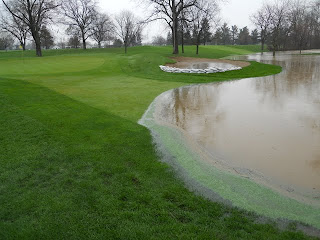With the golf course temporarily a flooded mess, I took a thorough walking tour this morning with my camera. The golf course and surrounding areas took over 1" of rain in yesterdays storm. Fortunately, the nighttime rain was minimal, but the creek continues to rise. We were forced to close the course today. Way too wet for carts across the entire course, and there was sufficient high water to make the bridges inaccessible by foot. As of 11 am, the water continues to rise, and I expect the creek won't crest for a few hours yet. Below are a few shots from this morning, and a few more shots about what we your maintenance staff is up to to keep the course as prepared as possible. Unfortunately, we have way too much practice at this, but hopefully we can keep the damage to a minimum. I will update with more pictures as the flooding and storms progress.
 |
| As of 7 am, water already backing up around #9 bridge. |
 |
| #17 cart path going under water |
In an effort to be as proactive as possible, the crew has squished their way out on the course and is placing a few sandbags to prevent traditional breach points from damage. #11 bunker has had its sand removed by flooding several times over the years, and we are doing what we can to prevent that.
 |
| Despite being closed, there are still some 'sandbaggers' on the course today. Bob and Aaron are using sand from the trap to fill the bags. |
 |
| Filled bags are placed along the leading edge. Floods from years past have completely removed all the sand from this trap and damaged the contours. It will take quite a bit of water to get over the extra foot plus from the sandbags. |
Many have already asked me today what the crew is up to. We have a few guys here today doing whatever they can given the situation. Guys are out mowing rough with push mowers where it is growing out of control, scooping piles of clippings from the fairways where puddles deposited them, pulling hazard stakes and tee markers to avoid getting washed down the creek, and just making as much progress as possible.
 |
| Yesterday's rains picked up clippings and leave them where in drains and low areas. |
 |
This pile is about an inch or more tall and quite large.
|
 |
Tough to keep smiling when scooping clippings. Note the standing water in the background if you wonder why we didn't let carts out today.
|
When spring weather is this cold and wet, one of the things you may see on the course now is our old friend snow mold. The same pathogen that makes disease under snow cover can rear its ugly head in a cold, wet spring. Hopefully we can get some decent weather soon so we can make our usual spring fungicide applications, which will clean it up nicely.
 |
| A spot of Microdochium patch. Note the 'frog's eye' of green grass in the center, a ring of white, diseased turf around it, and the active brownish ring of the patch on the outside. |
Another thing popping up with the wet weather is an abundance of worm 'castings'on the fairways and tees. Castings are a combination of soil, manure, and digested organic material that is left behind by active worms. They have been abundant this spring, with the wet weather, and can be messy. The upside is they are a great organic source of nutrients. Some people harvest, compost and sell them as high-end organic fertilizer.
















